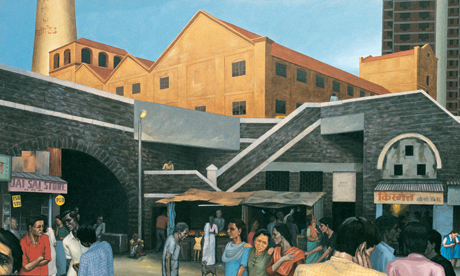Social Fabric: threads of colonialism laid bare

Sudhir Patwardhan, Lower Parel (part), 2001. Copyright the artist
Following boom and bust, revolution and oppression, Social Fabric at Rivington Place tracks colonialism and trade via the textile industry.
Featuring works by Alice Creischer and Sudhir Patwardhan, the exhibition stitches together contemporary and historic accounts to examine trade as a conduit for colonialism and the continuing influence exerted by a colonial past.
Alice Creischer’s large and complex installation, Apparatus for the Osmotic Compensation of the Pressure of Wealth during the Contemplation of Poverty, charts the systematic transfer of wealth from the colonies to Europe and the gravely imbalanced trading partnerships by which this was often accomplished.
Based on her travels to India, Argentina and Bolivia, the piece unfurls across the room, using a wide range of mixed media – photos, prints, even coin rubbings – to examine economics, history and debt. You have to duck under, sidle past and walk around delicate paper-cuts, spinning wheels and freestanding prints, exploring the complicated narrative they trace.
Statistics, commodification and tabulated measurements – tools traditionally used to express economic data – highlight colonial attitudes: the cold lists of calorie intake needed by Madras railway builders and the nameless faces which stare out from anthropometric photos are particularly powerful.
Sudhir Patwardhan’s paintings expose a widening gulf: Lower Parel depicts the burgeoning wealth of urban centres and emergence of a new middle class, against a backdrop of declining industry and workers’ struggles to save the mill.
Newspaper clippings and audio recordings bring to the life the various attempts by workers to strike and even occupy the mill, whilst an extensive film programme of rare footage gives an insight into the life of the mill and its workers.
Some of Marx’s most detailed letters on colonialism concerned British rule in India, and the presence of original papers alongside colourful paper labels from 1930s cotton bales, company paintings and deeds provide a historical grounding for the exhibition.
All are displayed on Celine Condorelli’s Meccano-like exhibition architecture which hints at industry and sharply contrasts with the delicate antique chintzes.
As well as providing an interesting historical account of the role of the textile industry in development both in Britain and abroad, this exhibition is a measured and thoughtful exposition of the lasting social, structural and economic presence of colonial nations in their subject states.
Social Fabric
Till 10 March
Rivington Place
Rivington Street EC2A 3BA
020 7749 1240
